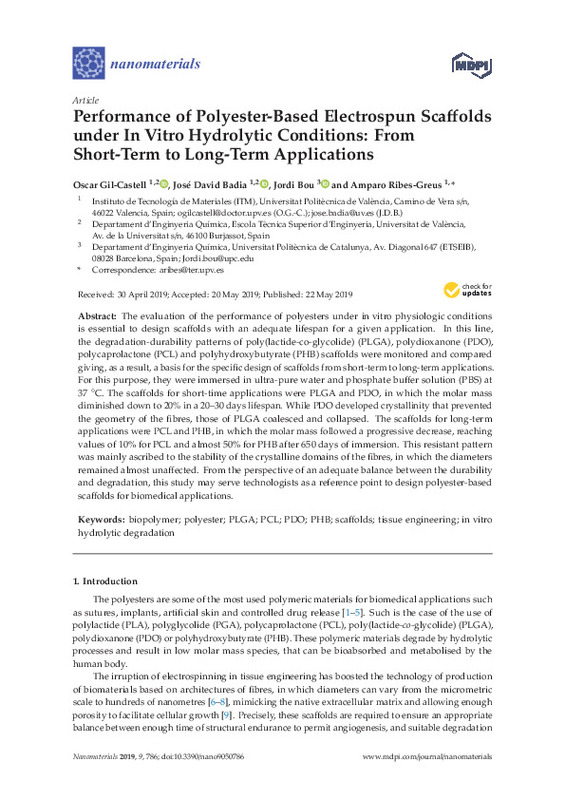JavaScript is disabled for your browser. Some features of this site may not work without it.
Buscar en RiuNet
Listar
Mi cuenta
Estadísticas
Ayuda RiuNet
Admin. UPV
Performance of Polyester-Based Electrospun Scaffolds under In Vitro Hydrolytic Conditions: From Short-Term to Long-Term Applications
Mostrar el registro sencillo del ítem
Ficheros en el ítem
| dc.contributor.author | Gil-Castell, O.
|
es_ES |
| dc.contributor.author | Badia, José David
|
es_ES |
| dc.contributor.author | Bou, Jordi
|
es_ES |
| dc.contributor.author | Ribes-Greus, A.
|
es_ES |
| dc.date.accessioned | 2023-06-20T18:01:26Z | |
| dc.date.available | 2023-06-20T18:01:26Z | |
| dc.date.issued | 2019-05 | es_ES |
| dc.identifier.uri | http://hdl.handle.net/10251/194413 | |
| dc.description.abstract | [EN] The evaluation of the performance of polyesters under in vitro physiologic conditions is essential to design sca olds with an adequate lifespan for a given application. In this line, the degradation-durability patterns of poly(lactide-co-glycolide) (PLGA), polydioxanone (PDO), polycaprolactone (PCL) and polyhydroxybutyrate (PHB) sca olds were monitored and compared giving, as a result, a basis for the specific design of sca olds from short-term to long-term applications. For this purpose, they were immersed in ultra-pure water and phosphate bu er solution (PBS) at 37 C. The sca olds for short-time applications were PLGA and PDO, in which the molar mass diminished down to 20% in a 20¿30 days lifespan. While PDO developed crystallinity that prevented the geometry of the fibres, those of PLGA coalesced and collapsed. The sca olds for long-term applications were PCL and PHB, in which the molar mass followed a progressive decrease, reaching values of 10% for PCL and almost 50% for PHB after 650 days of immersion. This resistant pattern was mainly ascribed to the stability of the crystalline domains of the fibres, in which the diameters remained almost una ected. From the perspective of an adequate balance between the durability and degradation, this study may serve technologists as a reference point to design polyester-based sca olds for biomedical applications. | es_ES |
| dc.description.sponsorship | This research was funded by MINISTERIO DE ECONOMIA, INDUSTRIA Y COMPETITIVIDAD, grant number ENE2017-86711-C3-1-R and by the MINISTERIO DE EDUCACION, CULTURA Y DEPORTE, grant number FPU13/01916. | es_ES |
| dc.language | Inglés | es_ES |
| dc.publisher | MDPI AG | es_ES |
| dc.relation.ispartof | Nanomaterials | es_ES |
| dc.rights | Reconocimiento (by) | es_ES |
| dc.subject | Biopolymer | es_ES |
| dc.subject | Polyester | es_ES |
| dc.subject | PLGA | es_ES |
| dc.subject | PCL | es_ES |
| dc.subject | PDO | es_ES |
| dc.subject | PHB | es_ES |
| dc.subject | Scaffolds | es_ES |
| dc.subject | Tissue engineering | es_ES |
| dc.subject | In vitro hydrolytic degradation | es_ES |
| dc.subject.classification | MAQUINAS Y MOTORES TERMICOS | es_ES |
| dc.title | Performance of Polyester-Based Electrospun Scaffolds under In Vitro Hydrolytic Conditions: From Short-Term to Long-Term Applications | es_ES |
| dc.type | Artículo | es_ES |
| dc.identifier.doi | 10.3390/nano9050786 | es_ES |
| dc.relation.projectID | info:eu-repo/grantAgreement/AEI/Plan Estatal de Investigación Científica y Técnica y de Innovación 2013-2016/ENE2017-86711-C3-1-R/ES/SISTEMA INTEGRADO DE DESCARBONIZACION Y PRODUCCION DE ENERGIA BASADO EN PILAS DE COMBUSTIBLE DE METANOL DIRECTO PARA APLICACIONES NAVALES Y AEROESPACIALES/ | es_ES |
| dc.relation.projectID | info:eu-repo/grantAgreement/MINISTERIO DE EDUCACION //AP2013-01916//AYUDA CONTRATO FPU 2013-GIL CASTELL/ | es_ES |
| dc.relation.projectID | info:eu-repo/grantAgreement/MECD//FPU13%2F01916/ES/FPU13%2F01916/ | es_ES |
| dc.rights.accessRights | Abierto | es_ES |
| dc.contributor.affiliation | Universitat Politècnica de València. Escuela Técnica Superior de Ingenieros Industriales - Escola Tècnica Superior d'Enginyers Industrials | es_ES |
| dc.description.bibliographicCitation | Gil-Castell, O.; Badia, JD.; Bou, J.; Ribes-Greus, A. (2019). Performance of Polyester-Based Electrospun Scaffolds under In Vitro Hydrolytic Conditions: From Short-Term to Long-Term Applications. Nanomaterials. 9(5):1-19. https://doi.org/10.3390/nano9050786 | es_ES |
| dc.description.accrualMethod | S | es_ES |
| dc.relation.publisherversion | https://doi.org/10.3390/nano9050786 | es_ES |
| dc.description.upvformatpinicio | 1 | es_ES |
| dc.description.upvformatpfin | 19 | es_ES |
| dc.type.version | info:eu-repo/semantics/publishedVersion | es_ES |
| dc.description.volume | 9 | es_ES |
| dc.description.issue | 5 | es_ES |
| dc.identifier.eissn | 2079-4991 | es_ES |
| dc.identifier.pmid | 31121950 | es_ES |
| dc.identifier.pmcid | PMC6566282 | es_ES |
| dc.relation.pasarela | S\395868 | es_ES |
| dc.contributor.funder | MINISTERIO DE EDUCACION | es_ES |
| dc.contributor.funder | AGENCIA ESTATAL DE INVESTIGACION | es_ES |
| dc.contributor.funder | Ministerio de Educación, Cultura y Deporte | es_ES |








